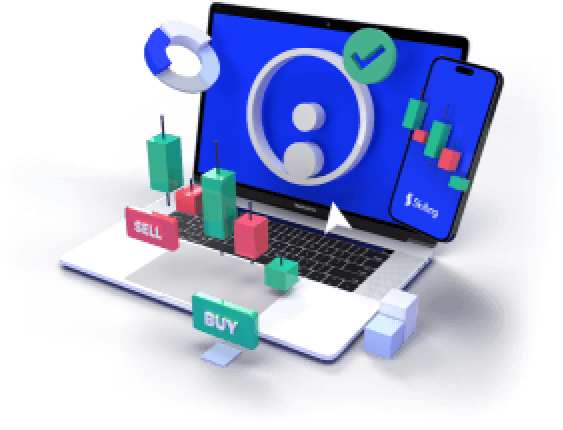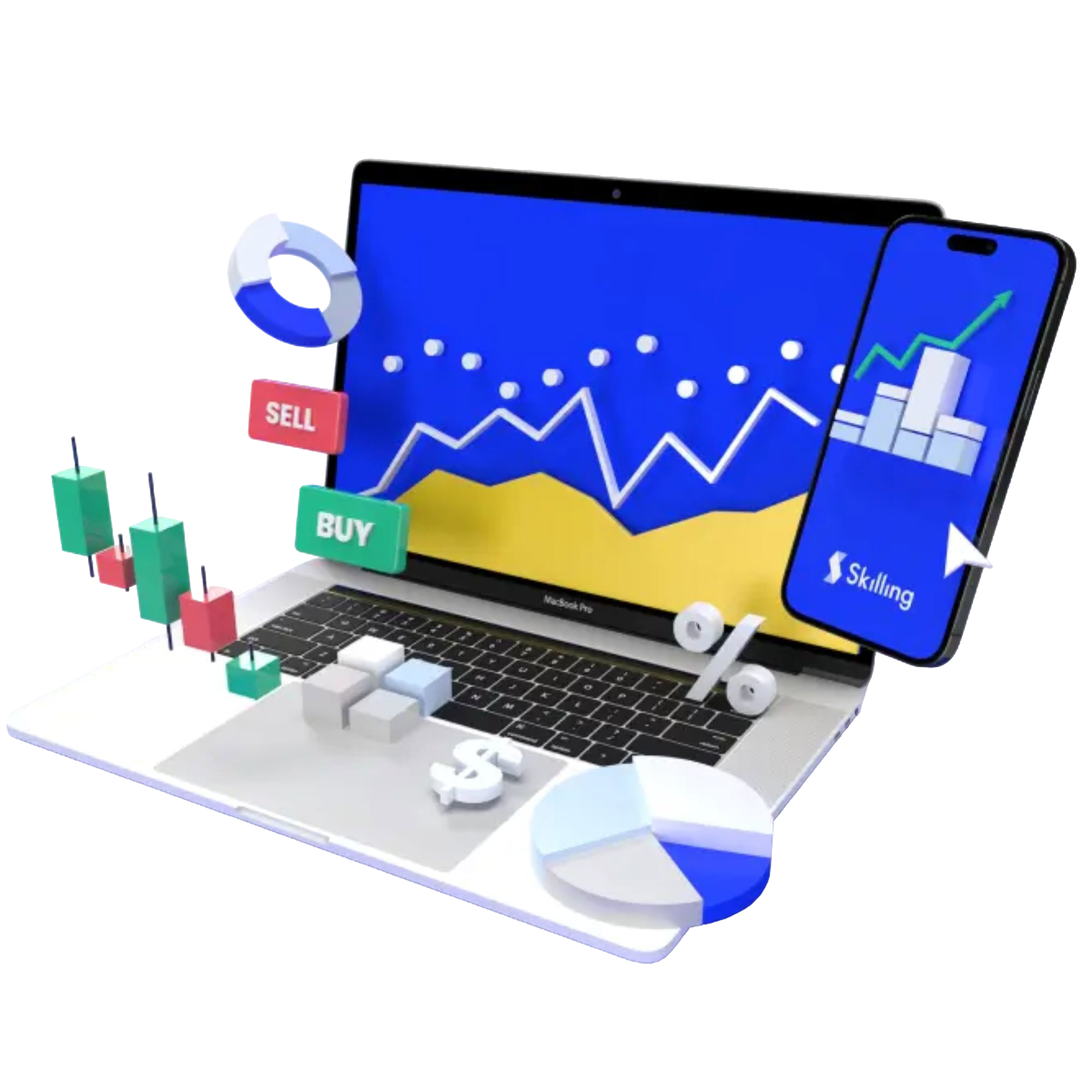Access 1,200+ global CFDs instruments.
Access a plethora of trading opportunities across the financial markets.

Access 1,200+ global CFDs instruments.
Access a plethora of trading opportunities across the financial markets.

The Wyckoff distribution model is an essential concept in technical analysis that offers traders valuable insights into market cycles and potential reversals. Created by Richard D. Wyckoff, this framework helps traders pinpoint when large institutions start offloading their holdings, often signaling an impending market decline.
Grasping the Wyckoff distribution cycle is crucial for making well-informed trading decisions and refining your strategies. In this article, we’ll explore the Wyckoff distribution cycle, present a practical example, contrast it with the Wyckoff accumulation phase, and discuss the advantages and disadvantages of the Wyckoff trading methodology.
What is the Wyckoff distribution cycle?
The Wyckoff distribution cycle represents a stage in the broader Wyckoff market framework where major institutional investors begin to sell off their assets following a period of accumulation and price increases. This stage is defined by distinct price movements that indicate the transfer of ownership from strong hands (institutions) to weaker hands (retail investors). Typically, this distribution phase foreshadows a market downturn or decline.
Practice with a Demo Account
Try our demo account and experience real market conditions.

Key components of the Wyckoff distribution cycle:
- Preliminary Supply (PSY) : This initial sign indicates that demand is being met with supply, often characterized by heightened volume and price volatility.
- Buying Climax (BC) : The price hits a peak, accompanied by robust volume, and then experiences a sharp decline.
- Automatic Reaction (AR) : Following the buying climax, a significant price drop occurs, establishing the lower boundary of the trading range.
- Secondary Test (ST) : The price attempts to retest levels near the buying climax to confirm supply presence.
- Sign of Weakness (SOW) : The price creates a lower high, signaling diminishing demand.
- Last Point of Supply (LPSY) : A final rally occurs before the price breaks down, affirming the distribution phase.
Wyckoff distribution - example
To illustrate the Wyckoff distribution cycle, let’s examine a hypothetical stock scenario:
- Preliminary Supply (PSY) : The stock price climbs to $100 with increasing volume, indicating initial signs of supply outstripping demand.
- Buying Climax (BC) : The price surges to $110 on high volume but quickly reverses.
- Automatic Reaction (AR) : Following the buying climax, the price drops to $95, establishing the trading range's lower boundary.
- Secondary Test (ST) : The price rallies back to $108 but fails to exceed the buying climax.
- Sign of Weakness (SOW) : The price drops to $92, forming a lower high, which indicates waning demand.
- Last Point of Supply (LPSY) : A final push to $105 occurs with lower volume before the price collapses to $85, confirming the distribution phase.
Trade Demo: Real trading conditions with zero risk
Trade risk-free on Skilling’s award winning platforms with a 10k* demo account.

What's your Trading Style?
No matter the playing field, knowing your style is the first step to success.

Differences between Wyckoff distribution and Wyckoff accumulation
Though both Wyckoff distribution and accumulation phases are integral parts of the Wyckoff market cycle, they serve distinct roles and occur at different points in the cycle.
| Feature | Wyckoff Distribution | Wyckoff Accumulation |
|---|---|---|
| Market Phase | Top of the market, preceding a downtrend | Bottom of the market, preceding an uptrend |
| Purpose | Large institutions offloading holdings | Large institutions acquiring undervalued assets |
| Price Movement | Characterized by selling pressure and lower highs | Characterized by buying pressure and higher lows |
| Key Indicators | Preliminary Supply, Buying Climax, Automatic Reaction, Secondary Test, Sign of Weakness, Last Point of Supply | Preliminary Support, Selling Climax, Automatic Rally, Secondary Test, Sign of Strength, Last Point of Support |
Pros and cons of the Wyckoff trading Method
The Wyckoff trading method comes with various strengths and some limitations. Understanding these factors can assist traders in determining when and how to employ this approach.
| Pros | Cons |
|---|---|
| Comprehensive Market Analysis: It offers a detailed framework for comprehending market cycles and institutional behavior. | Complexity: It necessitates a solid understanding of multiple phases and patterns, which can be daunting for newcomers. |
| Predictive Capability: It helps anticipate market reversals by highlighting accumulation and distribution phases. | Subjectivity: The interpretation of Wyckoff phases can be subjective and may differ among traders. |
| Enhanced Timing: It aids in optimizing entry and exit points, thereby minimizing the risk of false signals. | Time-Intensive: Chart analysis and phase identification can be labor-intensive, requiring continuous monitoring. |
Summary
The Wyckoff distribution cycle is a pivotal concept for traders aiming to identify market peaks and potential downturns. By understanding the essential components of the distribution phase and contrasting them with the accumulation phase, traders can enhance their market analysis and make more informed decisions. Despite its inherent complexity, the Wyckoff trading method provides invaluable insights into market dynamics and institutional behavior.
What's your Trading Style?
No matter the playing field, knowing your style is the first step to success.

FAQs
1. What is the Wyckoff distribution cycle?
The Wyckoff distribution cycle is a market phase where significant institutions divest their holdings, typically leading to a market downturn.
2. How does the Wyckoff distribution cycle operate?
The cycle encompasses phases such as Preliminary Supply, Buying Climax, Automatic Reaction, Secondary Test, Sign of Weakness, and Last Point of Supply, illustrating the transfer of ownership from strong to weak hands.
3. What distinguishes Wyckoff distribution from accumulation?
Wyckoff distribution occurs at the market's apex, foreshadowing a downturn, while Wyckoff accumulation takes place at the market's nadir, anticipating an upward trend.
4. What are the benefits and drawbacks of the Wyckoff trading method?
Pros include in-depth market analysis, predictive power, and improved timing. Cons encompass complexity, subjectivity, and the time-consuming nature of analysis.
5. How can the Wyckoff method improve my trading strategy?
The Wyckoff method aids traders in recognizing market cycles, predicting reversals, and refining entry and exit timing, leading to more strategic and informed trading choices.
By mastering the Wyckoff distribution cycle and integrating this methodology into your trading strategy, you can navigate market fluctuations more effectively and enhance your trading results. For further insights into market analysis and trading strategies, consider utilizing platforms like Skilling, which offer extensive resources and tools to elevate your trading experience.
Additionally, if you’re exploring CFD trading, it's crucial to stay updated on live market data, such as the current Bitcoin price, to make informed investment decisions.











